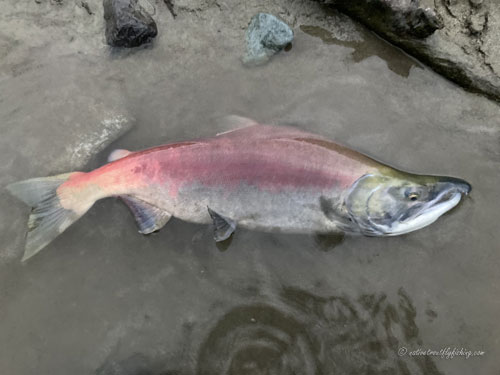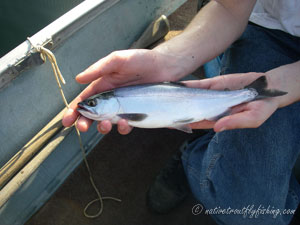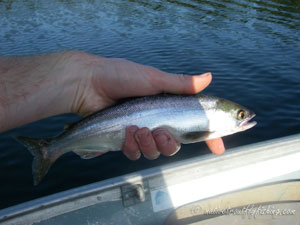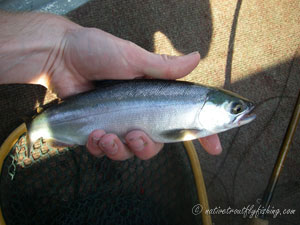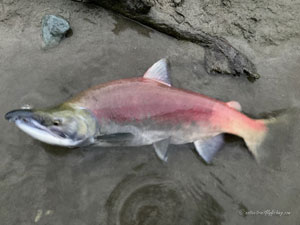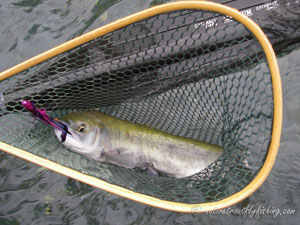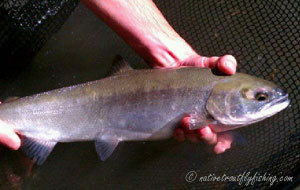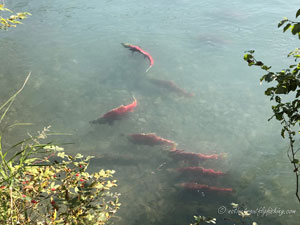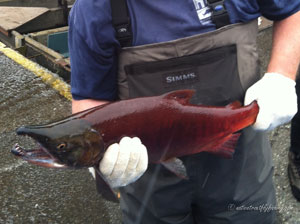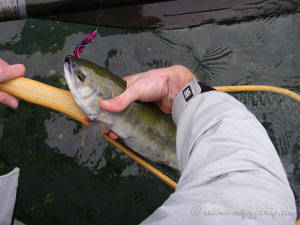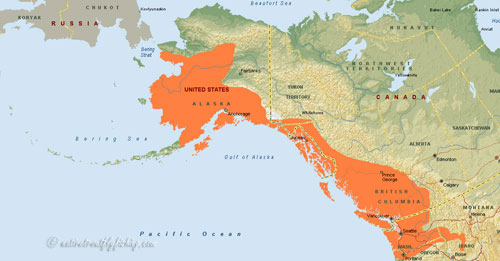Sockeye Salmon
Oncorhynchus nerka
A male Sockeye Salmon in its spawning colors.
Introduction
Sockeye Salmon are the second most abundant species of Pacific Salmon and the most important commercially harvested species. Sockeye Salmon have deeper red flesh than other salmon and are known for being a high-quality food fish and are prized as such. The world record Sockeye Salmon was caught on the Kenai River, AK and weighed 15.3 lbs (6.9 kg), the unofficial record Kokanee was from Lower Arrow Lake, BC and weighted 12.1 lbs (5.4 kg). Sockeye show the highest degree of dependence on lakes for rearing habitat of any Pacific Salmon and have a landlocked form called Kokanee Salmon. Sockeye Salmon have a single subspecies (sometimes considered a distinct species), the Black Kokanee or Kunimasu, which occurs in one lake in Japan (Moreira and Taylor 2015). Sockeye Salmon range from the Columbia River system to Kuskokwim River, Alaska in North America and are primarily found on the Kamchatka Peninsula in Asia (Burgner 1991). Other common names for Sockeye are Red or Blueback Salmon and Kokanee also called Silver Trout or Little Redfish.
Life History Information
Sockeye salmon like other species of Pacific salmon exhibit a wide variety of life history strategies. Most populations of sockeye salmon utilize lakes for rearing habitat and returning adults typically spawn in the outlet stream, tributaries that feed into the lake or in some cases even along the beaches themselves (Foerster 1968). Return timing varies across their native range, but these fish generally return to spawn during summer or fall, with earlier runs being more common in the northern part of their range. Once sockeye salmon reach their natal lake, they may reside there for between one and eight months prior to spawning. Sockeye are known to make long distance migrations to reach their spawning grounds and the upper Snake River population which spawns in Redfish Lake, Idaho travels nearly 1000 miles from the ocean.
Sockeye salmon produce small eggs, allowing females produce a large number of offspring. This small egg size also results in small offspring, which usually emerge from the gravel at around an inch long (Beacham and Murray 1993). In most populations of sockeye, shortly after emerging the fry travel to a lake where they reside for one to two years. It is thought that this lake dwelling behavior is a response to the small size of fry and is a tradeoff between slower growth found in lakes and the higher levels of mortality due to predation at sea (Quinn 2005). During the first month of lake residence, juvenile sockeye generally spend most of their time in the nearshore waters of the lake, than they move out into open water. In addition to anadromous populations of sockeye, there are also populations that spend their entire lives in lakes and are commonly known as kokanee. These kokanee were once believed to be a subspecies of sockeye, but recent studies have shown that populations of kokanee are more closely related to the anadromous sockeye from the same drainage than to each other (Talyor et al. 1996). While in lakes, sockeye salmon feed primarily on zooplankton and a variety of aquatic insects. Not all populations of sockeye rear in lakes and there are some populations that travel sea during their first year of life, or rear in a river for a year before migrating to marine waters. Once in marine waters sockeye salmon migrate north to the Gulf of Alaska, where they feed heavily on crustaceans such as euphausids and amphipods, as well as squid (LeBrasseur 1966). When compared to Chinook, coho and pink salmon sockeye have the lowest dependence on fish in their diet although fish may still make up a substantial portion of their diet (Manzer 1968). Sockeye generally return to spawn at four to six years of age, although jack males that return earlier do occur as well.
Status
Sockeye salmon appear to be holding their own rather well in the northern part of their range, however they are not fairing quite as well in the southern part of their range. There are currently seven genetically distinct stocks of sockeye in Oregon, Washington and Idaho that have been identified by NOAA. Out of these the Snake River population is designated as endangered and the Ozette Lake population is considered threatened with extinction (NOAA 2007). In the Columbia River system the construction of dams has been especially harmful to these fish can be directly linked with the extinction of several populations. Conservation efforts are underway to ensure the continued existence of the Snake River population, which is beginning to show signs of recovery as run sizes have reached 300 individuals after several years with no return during the early 1990's.
Description
Juvenile sockeye salmon exhibit a greenish olive back and silvery sides with 8 to 10 small oval parr marks. While residing in lakes or marine waters, the coloration of sockeye tends to be blue to olive on the back with silver sides. Kokanee generally attain a maximum size of 14" to 20" and one to three pounds while anadromous populations average between 21" to 26" and four to seven pounds. Kokanee may exhibit black spots above the lateral line and on the caudal fin, but spots are generally absent on anadromous fish. As sockeye salmon near spawning their coloration changes to give them green heads and red bodies, which has led to the name red salmon commonly being used for them. Like other species of Pacific salmon secondary spawning morphologies a more pronounced among male fish which develop a dorsal hump, larger teeth and a kype.
Fly Fishing Information
Sockeye salmon are known to be notoriously difficult to catch on fly gear, but with the right tactics it can be done. After the fish have been in a river system for a while, they can become quite aggressive and will attack bright swung of stripped streamer patterns. For kokanee when water temperatures are cold enough in spring, these fish can be found in surface waters and will often take chironomid patterns or even dry flies. As summer comes on and the water warms though, these fish seek the colder water below the thermocline and become much more difficult to catch. During this time sub-surface attractor patterns in pink, maggot imitations and daphnia flies fished deep on heavy sinking lines will often result in fish.
Kokanee: Lacustrine Form Sockeye
Click on images to view a larger picture
Anadromous Form
Native Range
A map of the native range of Sockeye Salmon in North America. Data Sources: Behnke (2002) and Augerot et al. (2005).
References
Augerot, X., Foley, D.N., Steinback, C., Fuller, A., Fobes, N., Spencer, K. 2005. Atlas of Pacific Salmon: The First Map-Based Status Assessment of Salmon in the North Pacific. University of California Press, Berkeley.
Beacham, T.D. and Murray, C.B. 1993. Fecundity and egg size variation in North American Pacific salmon (Oncorhynchus). Journal of Fisheries Biology 42: 485-508.
Behnke, R. 2002. Trout and Salmon of North America. Chanticleer Press, New York.
Burgner, R.L. 1991. Life history of sockeye salmon (Oncorhynchus nerka). In C. Groot and L. Margolis (editors), Pacific salmon life histories, p. 3-117. University of British Columbia Press, Vancouver.
Foerster, R.E. 1968. The sockeye salmon. Fisheries Research Board of Canada Bulletin. 162. Ottawa. 422 p.
LeBrasseur, R.J. 1966. Stomach contents of salmon and steelhead trout in the northeastern Pacific Ocean. Journal of the Fisheries Research Board of Canada 23: 85-100.
Manzer,J.I. 1968. Food of Pacific salmon and steelhead trout in the northeast Pacific Ocean. Journal of Fisheries Research Board of Canada 25: 1085-1089.
Moreira, A.L. and E.B. Taylor. 2015. The origin and genetic divergence of “black” kokanee, a novel reproductive ecotype of Oncorhynchus nerka. Canadian Journal of Fisheries and Aquatic Sciences 72: 1584-1595.
National Oceanic & Atmospheric Administration. Marine Fisheries Service. (2007). Sockeye Salmon. Retrieved May 5, 2008, from http://www.nwr.noaa.gov/ESA-Salmon-Listings/Salmon-Populations/Sockeye/Index.cfm
Quinn, T. 2005. The Behavior and Ecology of Pacific Salmon and Trout. University of Washington Press, Seattle.
Taylor, E.B., Foote, C.J., and Wood, C.C. 1996. Molecular genetic evidence for parallel life-history evolution within a Pacific salmon (sockeye and kokanee, Oncorhynchus nerka). Evolution 50(1): 401-416.
Contact
Feel free to contact me if you have any questions or comments
Native Trout Links
California Heritage Trout Challenge
Truchas Mexicanas' - Native Trout of Mexico
Balkan Trout Restoration Group
Trout and Seasons of the Mountain Village - About Japanese Trout
Fly Fishing Blogs
Dave B's Blog: Fly Fishing for Native Trout
The Search for Native Salmonids
Conservation Links
Western Native Trout Initiative
Fly Fishing Links
Fishing Art Links
Americanfishes.com - Joseph R. Tomelleri
